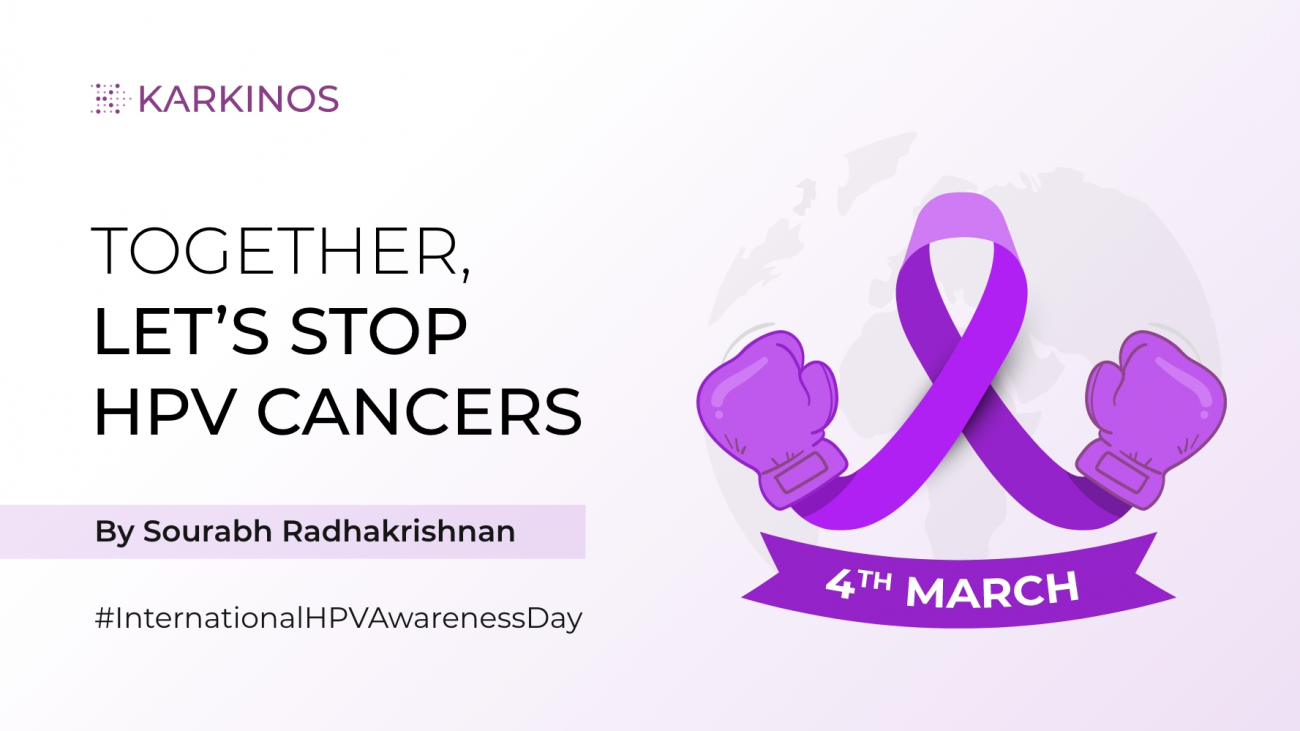A pledge to stop the spread of cancer-causing Human Papillomavirus
By Dr. Sourabh Radhakrishnan, Senior Consultant and Director, Medical Oncology HSCT, Karkinos Healthcare
It is the 4th of March –– the INTERNATIONAL HPV AWARENESS DAY and on this day organizations across the world spread the message on the dangers of the human papillomavirus (HPV) that has the potential to cause cancer. Let’s delve deeper into understanding all about this virus’ mode of action, how it causes cancer, and the best prevention options.
About Human papillomavirus
HPV is a group of over 100 viruses that infect the skin or moist areas of the body and is spread by skin-to-skin contact. Infection by this virus causes warts in various parts of the body. Almost all of us can contract HPV infection at some point in our life. They are usually harmless, mild or treatable infections in many of us while for many others HPV is linked to several kinds of cancer.
According to the World Health Organization (WHO), HPV is the most common sexually transmitted infection (STI) worldwide and is the leading cause of cervical cancer. Globally, there were an estimated 604,127 new cervical cancer cases in 2020, and 90% of the 342,000 deaths occurred in low and middle-income countries (LMICs).
About 40 of the 100 or more types of HPV can infect the genital regions and other mucous membranes (such as the mouth and throat), but only a few of these can cause cancer. HPV type 16 is closely related to various conditions including cervical, vulvar, vaginal, penile, anal, and oropharyngeal cancers. Two types of HPV – 16 and 18 – are responsible for 70% of cervical cancer and other HPV-related cancers.
HPV is commonly transmitted through skin-to-skin genital contact, vaginal, anal, and oral sex, and mucous membranes in the genital area. While HPV can cause cancers in men and women, currently the only test available for diagnosing HPV is the cervical screening test for women. Men are not routinely eligible for HPV testing and there is also no approved test for genital warts.
Different forms of warts are found to affect people in different age groups. Genital warts are the most common and highly contagious of them all, spreading via skin-to-skin contact. Warts often go without treatment in most people. In some cases, medications directly applied on the lesions will eliminate the warts. HPV vaccination would be recommended to prevent future infections, but is not a cure.
Symptoms to watch out for
Symptoms of early-stage cervical cancer may include:
- irregular blood spotting or light bleeding between periods in women of reproductive age;
- postmenopausal spotting or bleeding;
- bleeding after sexual intercourse; and
- increased vaginal discharge, sometimes foul smelling.
As cervical cancer advances, more severe symptoms may appear including:
- persistent back, leg or pelvic pain;
- weight loss, fatigue, loss of appetite;
- foul-smell discharge and vaginal discomfort; and
- swelling of a leg or both lower extremities.
Why is HPV screening important?
Almost everyone will at some point in their lives have HPV. Even though HPV is common, many women and even men will never know that they have contracted it, as the HPV-infected cells are often shed from the cervix with no medical intervention. So, the majority of people will never know they have the virus because it doesn’t always cause symptoms. The body’s immune system normally clears HPV infection within a couple of years.
However, for some, HPV can cause persistent infections that cannot be dealt with by their immune system. Persistent HPV infection in specific parts of the body can, in time, cause cells to change and this can lead to certain cancers including cancer of the cervix, vulva, vagina, penis, and anus as well as cancer in the throat and mouth including the tongue and tonsils.
Cervical cancer is by far the most common HPV-related disease. Nearly all cases of cervical cancer can be attributed to HPV infection. Though most HPV infections clear up on their own and most pre-cancerous lesions resolve spontaneously, there is a risk for all women that HPV infection may become chronic and pre-cancerous lesions progress to invasive cervical cancer. It takes 15 to 20 years for cervical cancer to develop in women with normal immune systems. It can take only 5 to 10 years in women with weakened immune systems. This is why screening is extremely important.
Screening is done among women who have no symptoms and may feel perfectly healthy. When screening detects an HPV infection or precancerous lesions, these can easily be treated and cancer can be avoided. Screening can also detect cancer at an early stage where treatment has a high potential for cure.
Cervical screening can check for HPV infection and for changes in the cells of the cervix There are two types of screening tests to help detect early signs of cervical cancer.
- PAP/SMEAR TEST: This test has been used for many decades to look for precancerous cell changes of the cervical cells. Cells from the cervix are sent to a lab and looked at closely to see if the cells are normal or if changes can be seen. Pap smear results indicate whether cervical cells appear normal, abnormal, or if the test result is unclear.
- HPV DNA TEST: This is a more sensitive test which looks specifically for the presence or absence of HPV in the precancerous cells. In HPV DNA testing, a patient’s cells are examined in a laboratory for the genetic material (DNA) of HPV. If evidence of HPV is detected, HPV genotyping may be performed to determine the specific strain of HPV causing infection.
An abnormal screening result requires additional tests such as colposcopy, VIA or cytology. In a colposcopy a small microscope is used to examine the cervix in more detail. The healthcare professional doing the colposcopy may use dyes to stain the cells in the cervix to make it easier to see any changes to the cells. They may also take a small sample of the cervix (a biopsy) for further investigation. The VIA procedure is similar to colposcopy, but it does not use a microscope, it is done by a visual assessment and evaluation of the cervix. As with the colposcopy, stains are often used to better observe any potential lesion(s) requiring treatment.
The frequency of the screening tests depends on the results of the screening test. If the results are normal, the frequency could be every three to five years. Programs that use the more sensitive HPV testing often increase the frequency to at least 5 years for women who do not have any evidence of HPV infection. Women over age 30 with no screening test records have a much higher risk of developing cervical cancer.
Vaccination is the best prevention
Although it is the second leading cause of cancer deaths among women, cervical cancer is highly preventable by implementing a universal HPV vaccination program for both sexes, particularly girls, before they become sexually active. Trials and real-world data from population-based studies have now demonstrated that the vaccines greatly reduce the risk of pre-cancer and cancers of the cervix, vagina, and vulva in vaccinated women.
WHO strongly recommends HPV vaccination as the most effective primary prevention measure for both sexes aged 9–14 years. HPV vaccines have also been found to reduce infections in other tissues that HPV infects, including the anus and oral region. Because the cell changes and cancers caused by HPV take years to develop, studies confirm that the vaccines reduce the risk of these outcomes as well.
Karkinos Healthcare’s efforts in mitigating HPV causing cervical cancer is aligned with WHO’s global strategy to accelerate the elimination of cervical cancer as a public health problem.
The definition of elimination of cervical cancer has been set up as a country reaching the threshold of less than 4 cases of cervical cancer per 100 000 women per year. To reach this threshold by the end of the 21st century, WHO has set up the 90-70-90 targets to be reached by 2030.
- 90% of girls fully vaccinated with HPV vaccine by age 15;
- 70% of women are screened with a high-performance test by 35, and again by 45 years of age.; and
- 90% of women identified with cervical disease receive treatment (90% of women with pre-cancer treated; 90% of women with invasive cancer managed).
In order to contribute to achieving the goals set by WHO and to help the country fulfill its commitment towards this global strategy, Karkinos Healthcare will conduct widespread outreach and screening programs. These programs will create awareness among the school community, parents, teachers and other stakeholders and also screen girls of age groups 9-14 for early cervical cancer detection.
Karkinos Healthcare will target the most vulnerable children and population that can contract the HPV infection to create awareness on the nature of HPV infection, its cancer causing consequences, availability of screening tests and the preventive vaccine options available in the country. Karkinos Healthcare will also partner with local health bodies, hospitals, and vaccine providers to ensure that the company aligns its vision with WHO’s cervical cancer elimination goals.

 About Dr. Sourabh Radhakrishnan
About Dr. Sourabh Radhakrishnan